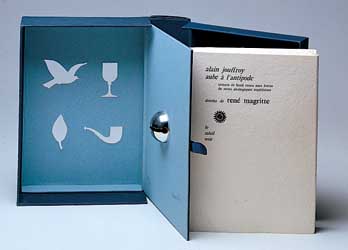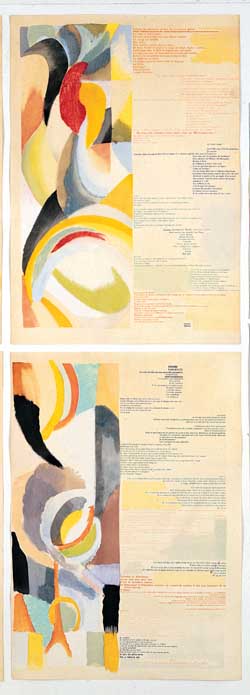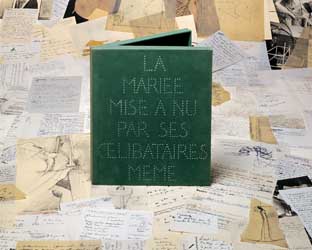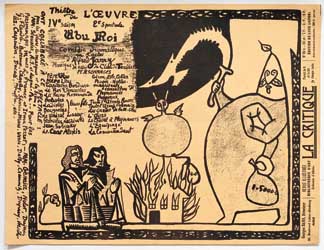
Contact Information (press inquiries only) The New York Public Library Public Relations Office 8 West 40th Street New York, NY 10018 phone: 212.221.7676 fax: 212.768.7439 |
Groundbreaking Collaborations Between Artists and Poets of 19th and 20th Centuries on Display at The New York Public Library French Book Art | Livres d'Artistes: Artists and Poets in Dialogue on View May 5 through August 19, 2006 Exhibition Features Joint Works by Stephane Mallarmé and Edouard Manet, Tristan Tzara and Pablo Picasso, Jules Renard and Henri de Toulouse-Lautrec, and more
Delicate line drawings by Edouard Manet, brilliantly colored brushstrokes by Pablo Picasso, and eye-catching watercolors by Joan Miró -- all designed to appear between the covers of a book -- are some of the highlights of a new exhibition, French Book Art | Livres d'Artistes: Artists and Poets in Dialogue , opening May 5, 2006, at The New York Public Library. Although better known for their works on canvas, artists such as Picasso, Henri Matisse, and René Magritte collaborated with poets such as Mallarmé, Apollinaire, Gide, and others to pioneer the concept of the artist's book, in which words and pictures come together in a unique fashion, ushering in a new mode of expression. Beginning in France in the 1870s, as a vibrant arts scene was emerging following the Franco-Prussian War (1870-71), these joint ventures between artists and poets produced some of the world's most richly imagined artists' books. The exhibition consists of 126 books created between 1874 and 1999, many of which are accompanied by counterpoints, original works of art relating to or contrasting with the books on display. Also featured are photographs and sculpture depicting many of the artists and authors represented in the exhibition. The exhibition is co-organized by the Bibliothèque littéraire Jacques Doucet, Paris, and The New York Public Library, with items drawn from the renowned collections of both institutions, along with rarely seen works from private French collections. The exhibition is curated by Yves Peyré, director of the Bibliothèque littéraire Jacques Doucet, with the assistance of H. George Fletcher, the Brooke Russell Astor Director for Special Collections at The New York Public Library. The Library is the sole United States venue for the exhibition. Admission is free. "This extraordinary exhibition illustrates the birth of a new means of expression, the artist's book," said President of The New York Public Library, Paul LeClerc. "The New York Public Library is proud to join with the Bibliothèque littéraire Jacques Doucet in presenting this exhibition, which includes significant material from the Library's own collections and spotlights an exceptionally creative period during a time of significant social, economic, and artistic change in Europe." Noted for their striking beauty, unique formats, and variety in size and theme, the artists' books on view are distinguished in their page design, typography, imagery, printing processes, and paper quality. From watercolors and washes to etchings and woodcuts, the artworks carry the signature styles of such masters as Picasso, Matisse, and Miró. Related drawings, etchings, pamphlets, posters, and manuscript pages serve as counterpoints, offering context and background for the collaborations between the artists and poets. In addition, a portrait gallery constitutes an exhibition within the exhibition, presenting photographs of many of the featured artists and poets by master photographers such as Nadar, Brassaï, Man Ray, and Henri Cartier-Bresson. The Collaborative Process The exhibition traces the history of the French avant-garde movement in art and literature, which sought to break from established norms of book publishing and traditional standards of typography, printing, page design, and paper selection. With the advent of free verse and the abandonment of rhyme, fixed form, and meter, poets were free to play with the arrangement of words on the page, creating a natural dialogue with the visual arts. The books on view illustrate the creative contribution made by artists and poets associated with a wide variety of artistic movements, including Symbolism, Cubism, Dada, Surrealism, and Existentialism. The collaborators worked as equal partners, each contributing a balanced proportion of the whole. On occasion, an individual poet or artist was responsible for both text and image, resulting in a dialogue with the self.
"This exhibition provides a unique opportunity for the public to view some rarely exhibited items from the Library's special collections in a context that reveals their greater artistic and literary significance," said David Ferriero, Andrew W. Mellon Director and Chief Executive of The Research Libraries. "Showing these items in conjunction with items from the Bibliothèque littéraire Jacques Doucet helps us enhance access to and appreciation of our treasures, and introduce items from across the globe to local audiences." "The works selected for display constitute a memoir of an exceptional moment in art and literature; so exceptional, in fact, that the authors of these two modes of expression tested each other mutually, supporting, confronting, harmonizing with each other within the unique space of the page, their only rule being the desire to invent together," said Yves Peyré, exhibition curator and director of the Bibliothèque littéraire Jacques Doucet. The Birth of the Book of Dialogue Beginning in the 1870s, France offered the ideal environment for artists and poets of diverse nationalities to come together in creative collaborations that experimented with received notions of book art and set new standards for expression. Artist Edouard Manet and poet Stephane Mallarmé are considered the originators of this new form, which, owing to its collaborative nature, may be termed the book of dialogue. Their L'Après-midi d'un faune ( The Afternoon of a Faun ), 1876, a simple volume of poetry with delicate line drawings heightened with pink watercolor by Manet, was a model for subsequent books of dialogue. Modestly received upon publication, the book quickly grew in popularity. Mallarmé proudly touted to a collector in 1879 that it could no longer be found in bookstores and its price had doubled in only three years. Manet's six illustrations for Le Corbeau, Mallarmé's translation of Edgar Allan Poe's poem The Raven, earned iconic status in the history of the artist's book when it was published in 1875. Printed in an edition of 240, the work was a financial failure but an artistic triumph. Manet's spare illustrations masterfully bring to life Poe's haunting poem and anticipate Mallarmé's famous dictum of 1891 that "to name an object is to suppress three-quarters of the enjoyment of the poem. . . . To suggest it, that is the dream." Other notable books from this period include Le Voyage d'Urien ( Urien's Voyage ), 1893, by André Gide and the artist Maurice Denis, about a fictional voyage across a world of boredom to the mer glaciale -- "frozen sea" -- of puritan morality; Histoires naturelles ( Natural Histories ), 1899, by Jules Renard and Henri de Toulouse-Lautrec, a new form of bestiary in which animals assume the characteristics of human beings; and Alfred Jarry's Les Minutes de sable mémorial ( The Minutes of a Monument in Sand ), 1894, for which Jarry contributed both text and images. The New Century A new century brought attempts, influenced by Cubism, Dada, and Surrealism, to liberate painting and poetry from traditional notions of form and meaning. Dedicated to finding new ways to enhance the meaning and resonance of his poems, the poet Pierre Reverdy focused on the arrangement of words on the page, preferring nonstandard punctuation and line breaks. Reverdy's collaborations with Matisse on Les Jockeys camouflés & Periode hors-texte ( The Camouflaged Jockeys & Period in the Margins ), 1918; with Juan Gris on La Guitare endormie ( The Sleeping Guitar ), 1919; and with Pablo Picasso on Cravates de chanvre ( Hemp Neckties ), 1922, heightened the Expressionist quality of his poems. One of the most extraordinary artists' books created during this period, La Prose du Transsibérien et de la petite Jehanne de France ( The Prose of the Transsiberian and of Little Jeannie of France ), 1913, by poet Blaise Cendrars and artist Sonia Delaunay, evokes a train journey from Russia to Paris. Cendrars' text occupies the right-hand side of four joined pieces of paper, which were intended to be folded like a road map, while Delaunay's striking visual accompaniment of cascading forms, colored in pochoir (stencil), fills the left. Apollinaire claimed that the color contrasts in the work "enable the eye to read the whole poem at a glance, just as the conductor of an orchestra reads at once the superimposed notes in a piece of music." Most notably, the collaborators intended that, when laid end to end, the 150 copies of the first edition would equal the height of the Eiffel Tower. Between the Wars and After Throughout the period, as poets and artists experimented with different forms of expression, the physical format of the book itself began to evolve. One of the most unusual in format, Marcel Duchamp's La Mariée mise à nu par ses célibataires, même [ The Bride Stripped Bare by her Bachelors, Even ], also called La Boîte verte [ The Green Box ], 1934, is made up of 93 separate pieces of text and images--including handwritten notes, photographs, and schematic drawings charting the progress of his work Grand Verre (1915-23)--housed in a green felt box. Duchamp advocated the art of the "ready-made," taking familiar objects from everyday life and redeploying them in his work. He intended the pieces that make up this work to be juxtaposed at random, to obtain an infinite variety of meanings and forms.
World War II stimulated an expressiveness that was manifest in works both grand and simple. Reverdy and Picasso again collaborated to create Le Chant des morts ( The Song of the Dead ), 1948, in which Reverdy's oversized hand-written text was joined with Picasso's brilliant orange calligraphic marks, punctuation, and hieroglyphs in a manner that literally underscored the emptiness and decay evoked by the text. Countering the trend to position the artist's book as a luxury item, Jean Dubuffet's Ler dla campane ( Dee Contree Err ), 1948, was stenciled on cheap newsprint in a childlike hand, with crude prints made from the wooden bases of used Camembert cheese containers. The title is a rough, phonetic spelling (a play on "L'Air de la campagne," or "The Country Air") that is in keeping with the artist's obsession with the ordinary and the mundane. Given the risk that the book of dialogue would become formulaic, its creators were constantly in search of novel approaches and styles. One of the most unusual books produced during the postwar period was a collaboration between the poet Tristan Tzara and Picasso, Le Rose et le chien ( The Rose and the Dog ), 1958. The book was subtitled "Poème Perpétuel" ("Perpetual Poem"), since its pages included moveable parts that enabled a reader to change the words of the poem, which was composed as a series of concentric circles rather than straight lines of text. Picasso provided drypoints and etchings on celluloid for the work. Like the book itself, the title was modifiable: La Rose et le chien was an anagram of La Chose et le rien ("The Thing and the No-thing"). In more recent decades, artists and poets have continued to take the artist's book in new directions by pushing the boundaries of form and structure. In Laisses ( Leashes ), 1975, by André du Bouchet and Pierre Tal Coat, brightly colored aquatints and woodcuts face broken fragments of poetry in an oversize volume. Au travail ma chérie ( Darling, Get to Work ), 1992, by Dominique Fourcade and Pierre Buraglio features erasures, underlinings, and quotations in a manner both poetic and graphic. Collaborations between Michel Deguy and Bertrand Dorny resulted in magnificent collages in which Dorny incorporates found materials of diverse textures, forms, and colors. "How fitting that our exhibition, designed in collaboration with the Bibliothèque littéraire Jacques Doucet, celebrates the nature of collaborations," said H. George Fletcher. "The innovative works on display manifest the creative potential that a great collaboration can unleash." The Counterpoints
Many of the counterpoints on view allow for additional pages of text or illustrations contained within a book to be shown simultaneously, such as the additional illustrations by Manet for Poèmes d'Edgar Poe, 1889. Other items add context to the pages and images on display, including a lithograph promoting Jarry's Ubu roi ( King Ubu ), 1896; corrected versions of Tzara's Vingt-cinq poèmes ( Twenty-Five Poems ), 1918; Picasso's portrait of Reverdy, 1922; and Alberto Giacometti's Portrait d'André du Bouchet, 1961. A Note on the Exhibition French Book Art | Livres d'Artistes is the fourth incarnation of an exhibition conceived by Yves Peyré and previously shown at The Fitzwilliam Museum, Cambridge, England; the Bibliothèque municipale de Lyon; and the Sorbonne, Paris. The exhibition will be on view May 5 through August 19, 2006, at The New York Public Library's D. Samuel and Jeane H. Gottesman Exhibition Hall on the first floor of the Humanities and Social Sciences Library, Fifth Avenue and 42nd Street. The 126 featured items are drawn in equal measure from the collections of the Bibliothèque littéraire Jacques Doucet and The New York Public Library, with the exception of three books from private collections; the counterpoints and the photographs and sculpture are from the collections of the Doucet or private collections in France. New York Public Library materials are primarily from the Spencer Collection, with additional items from the Print and Photography collections of The Miriam and Ira D. Wallach Division of Art, Prints and Photographs, the Rare Book Division, and the General Research Division. The exhibition introduction and the section texts were written by Yves Peyré, translated by Anne Walker, and adapted by H. George Fletcher. The label copy was adapted from text written by Jane Munro for the version of the exhibition shown at The Fitzwilliam Museum, Cambridge; additional label copy was written by H. George Fletcher. The exhibition timelines were prepared by Christina von Koehler, with contributions from Anne Skillion. Docent Tours About the Bibliothèque littéraire Jacques Doucet French Book Art | Livres d'Artistes: Artists and Poets in Dialogue is on view May 5 through August 19, 2006, at The New York Public Library's Humanities and Social Sciences Library, Fifth Avenue and 42nd Street, in the D. Samuel and Jeane H. Gottesman Exhibition Hall on the first floor. Exhibition hours are Tuesday and Wednesday, 11 a.m. to 7:30 p.m.; Thursday through Saturday, 10 a.m. to 6 p.m.; Sunday, 1:00 to 5:00 p.m. through May 21; closed Sundays (as of May 28), Mondays, national holidays, and Saturday, May 27. Admission is free. For more information about exhibitions at The New York Public Library, the public may call 212.869.8089 or visit the Library's website at www.nypl.org. This exhibition has been organized jointly by the Bibliothèque littéraire Jacques Doucet, Paris, and The New York Public Library. ### Contact: Tim Farrell 212.704.8600 TJF:04.24.05:nypl022
|




